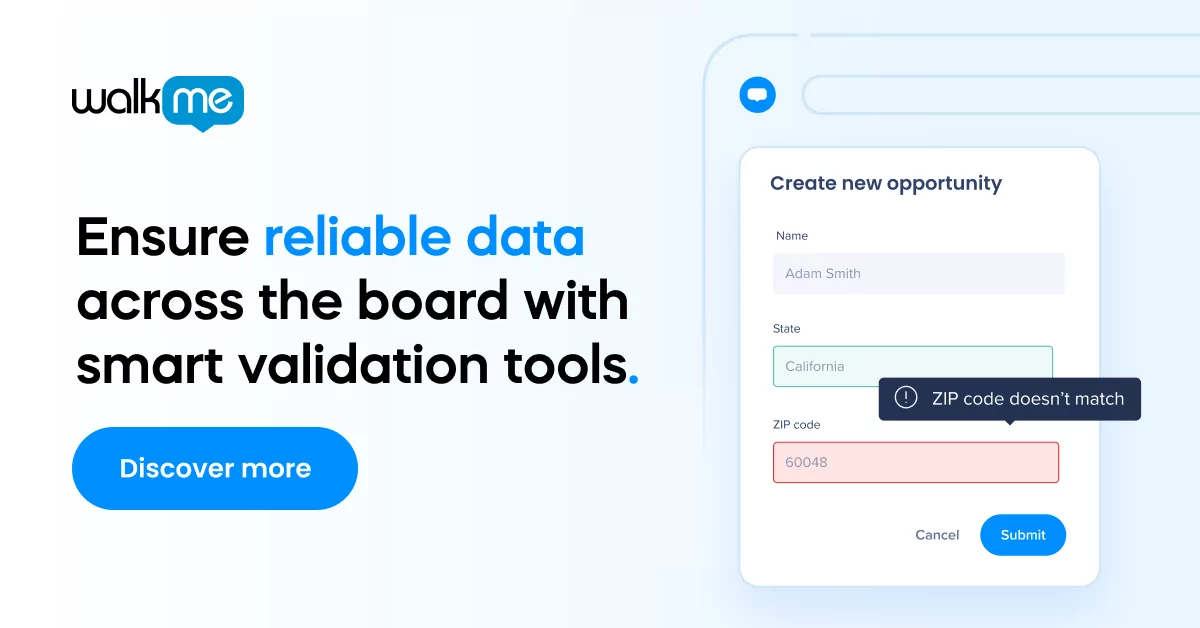In a traditional classroom, a trainer and learners form a relationship, allowing personalized content to be offered up and tailored specifically to those individuals at that moment in time. With asynchronous, or on-demand learning, this relationship is non-existent. The learner is left alone on their training journey using self-help tools. Although the convenience factor allows them to choose the time and place that training occurs, any tailored instruction falls by the wayside. There is no one on the other side responding to their feedback, let alone actively drawing them into a community.
Building a relationship with both learners and users is where a Digital Adoption Platform (DAP) shines, enhancing self-service learning by empowering meaningful personalization and – ultimately – powerful relationships with your system’s adopters.
Relationship built of valuing uniqueness
I (Josh) work at iVvy, a cloud-based SaaS company that offers meeting planners the ability to search, compare, book and pay for function space, catering and group accommodations online, 24/7. By providing conference centers, hotels, restaurants and cruise lines with an integrated revenue management and distribution platform, our users are given greater visibility over their business. They can then yield their group rooms, meetings and event spaces to maximize revenue. My responsibility is to provide a streamlined experience through training and onboarding users on how best to use our platform to achieve a significant ROI.

As iVvy grew, conducting face-to-face training became quite burdensome. I put together a successful case to deploy WalkMe, a DAP that allowed worldwide users on our system to learn on their own time and at their own pace. Although we had eLearning modules before, utilizing a DAP is a vastly different experience. Now, I am able to have a relationship with my users that rivals the relationships I built when I was standing in front of a classroom in person.
Because of the wide range of user data available within the DAP, it enables you, as a DAP professional, to build a customized experience that enhances not just the personalization of the users’ journey into your underlying systems, but a relationship based on acknowledging and enhancing their value to the organization.
The fine dining experience
Before we get into the specifics of how DAP accomplishes this, let us first start with getting on the same page of why a personalized journey is necessary for digital adoption. The way that quality restaurants treat their guests during the entire meal – from greeting them to turning-over their table – all focuses on providing a top-notch experience in which diners feel like the meal was made exclusively for them.
In high-end establishments, diners are met on arrival and called by name. They are seated at a table and told the specials of the day. Servers do not hover, but correctly anticipate when they are needed, precisely appearing at just the right time to ensure diners are enjoying themselves. Cues are present for the waitstaff to bring out each serving. After dessert, as the diners are still basking in the ambiance, they are asked how the meal was and if there is a way to improve. Once the guests leave, they are thanked once again by name, and any suggestions are noted to improve their experience for the next time.
All of these actions build stronger relationships between the restaurant and its patrons to create fiercely loyal adopters. Why can’t systems training have the same level of care and personalization as a fine dining experience? With a well-built DAP, it can.
Let’s continue with the restaurant analogy to show how DAP can create a personalized experience that users will want to continue to come back to again and again.

We call you by name
First, diners are met on arrival and called by name. There is nothing more powerful than connecting with a person by greeting them by name. In a classroom setting, it builds instant rapport; in an asynchronous setting, it grabs the learner’s attention and instantly broadcasts their value. Using DAP, we can tap user data and even integrate with identity management platforms across systems with a simple goal — show our users’ value through calling them by name.
We insert this variable into a shout-out that greets them, “Hi, Lauren, how can we help you today?” or have a mini-menu pop-up with three of our site’s most used features, asking, “James, what are you wanting to achieve?” We go beyond just greeting them with their name to also congratulating them when an on-boarding task has been accomplished or wishing them well as they leave our system, each by their name. Through a DAP, we can create that most basic human connection and reinforce their value as an individual.
We remember your unique preferences
Just as a server seamlessly remembers a diner’s food preferences, DAP employs the same level of personalization by tracking users’ preferences and roles. When new users log into our system, we tag them into specific segments as they fill out a DAP survey during their initial welcome to the iVvy family. We ask them who they are and what they do (e.g., catering, sales, accounting, etc.). With this information, we customize our meal based around their unique appetite.
An example of this unique customization is a field validation for one of our customers. A customer is extremely concerned about data integrity and requires a phone number to be in a specific format so that their legacy systems can recognize the data when exported. Using our DAP’s SmartTip validations that are segmented for that single company, we ensure their team follows the prescribed format while allowing the other 99.9% of our users to fill in phone numbers appropriate to their systems. In restaurant terms, while one of our guests prefers their steak pre-cut into bite-sized pieces, the flexibility of a DAP to personalize an experience ensures that we do not cut everyone’s steak that way.
We value your experience
Additionally, based on their past behaviors in our system, while seating them into the flow of work in our platform, we offer up their “regular” wine bottle, while also informing them of new special features that we think they might enjoy or adopt to a greater extent. We even go as far as recognizing through WalkMe data the experience level of each user. Users are congratulated on “advancing” based on their goal accomplishments and other tracked events (by name, of course). New features and experiences are then opened to match their level.
The point is not to just generically post information, but to celebrate their status and let them know their experience is valued by tailoring offered specials that suit their interests and needs. Just as the astute server would never offer a white wine when the guest prefers red (unless the white is best paired with their meal), so too would we never blast information that is not aligned with our users’ status or preferences (unless it is an opportunity to try a new tool that would enhance their productivity).
We personalize the entire journey
Our personalization of the users’ journeys does not stop there. Through Digital Customer Experience analytics, DAP goal tracking, and webhooks, we are able to see where assistance is needed in their journey and quickly pivot to either bring more water (encourage users to keep going through their process via pop-ups) or bring the next serving (link potential Smart Walk-Thrus together to aid users in their flow-of-work). While the experience is fresh in their minds, we reinforce the value of our users’ opinions through a quick survey at key moments in their journey and also use tracked events and funnels to improve their interaction with our system the next time they visit.
Results of a relationship-building DAP
Due to the flexibility, responsiveness, and wealth of data that our DAP enables, it has become a mini-CRM that is uniquely designed to welcome and empower users as iVvy family members.
The results of this relationship-building are clear. A recent example of how our users feel valued at iVvy is measuring our email campaign success. Before implementing a DAP, our campaign open rate hung out at 3%. Once a DAP was deployed, and the information we gathered from relational interactions with our users allowed us to personalize our campaigns, our open rate shot up to 60% — three times our industry average!
As a DAP professional, never underestimate the power of personalization. By using a DAP’s segmentation and data tracking features, you can value your users by greeting them by name throughout their session, tailoring their journey based on their experience, and quickly respond to their changing needs. In short, DAP allows you to build a two-way relationship with your users that is foundational to not just adopting your systems, but to become devoted fans of your company’s ecosystem.
Bon appetit!


